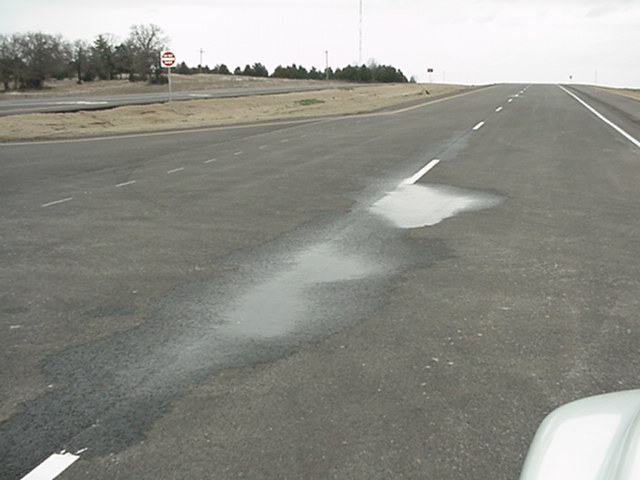
We are sometimes confronted with an asphalt pavement where we can see lingering signs of moisture after a rainfall event.
These wet spots lead to several questions:
- Why doesn’t this area of the pavement dry as quickly as other areas?
- What brought about this issue?
- Will this cause long-term damage to the pavement?
- What can be done to prevent this problem on future roadways?
- What can be done to mitigate the problem on existing pavements?
We refer to the problem of moisture in dense-graded HMA mixes as permeability. Permeability can be defined as interconnected air voids which allow air, water and water vapor to infiltrate a pavement structure from the surface and/or the base.
Permeability can initiate pavement distresses of two primary types—oxidation and stripping. Oxidation occurs when the asphalt is exposed to the air, causing it to become brittle over time. Stripping occurs when the asphalt binder is separated from the aggregate in the presence of water or water vapor, resulting in a reduction of support and stability.
Identifying the cause of the problem
Permeability is usually caused by one of the following:
- Poor roadway compaction (low density), which most commonly occurs at the longitudinal joint, or
- An aggregate structure in the mix that is inherently permeable.
Most roadway permeability issues are a result of poor compaction at the longitudinal joint. Specifications typically target about six percent in-place air voids within the mat, but poorly-compacted joints can have 12 percent or more in-place air voids. Well-constructed joints should have no more than ten percent in-place voids, and have no more than two percent additional air voids when compared to the mat.
Pavement geometry is designed to channel surface water to the side drainage channels through crowns and transverse slopes. However, voids at the longitudinal joints can intercept the sheeting water and allow it to infiltrate into the pavement structure.
Pavement permeability could also be caused because the asphalt mixture itself is unintentionally designed to be inherently permeable. Although many dense-graded mixes are specified at six percent in-place air voids, the distribution of those voids makes the difference in whether or not the mix is permeable. Even if the mix has the same percentage of voids by volume, fewer, larger voids conduct water easier than the equivalent volume of smaller-sized voids. Consequently, mixes with a larger nominal maximum aggregate size (NMAS) are inherently more permeable than mixes with a smaller NMAS. Likewise, coarser mixes within the same NMAS mix category are inherently more permeable than finer mixes. NCHRP Report 531 goes into more detail regarding similar findings.
Preventing future permeability problems
To help identify inherently permeable mixtures, a lab permeability test can be specified. This test measures the rate at which water flows through a compacted asphalt specimen. Most specifications allow permeabilities up to 125 x 10-5 cm/s. However, the Oklahoma Department of Transportation (ODOT) evaluated the test paramaters and found that a 65 cm tall column of water could pass through the specimen in about 5 1/2 minutes and still meet the 125 x 10-5 cm/s criterion. Because that still seemed too permeable, ODOT lowered the criterion by a factor of 10, to 12.5 x 10-5 cm/s.
In the ODOT study they compacted multiple samples, controlling the aggregate size distribution of a 1 inch NMAS mix from as coarse as possible to as fine as possible. Each of the 6 size fractions was then compacted in one percent increments to densities from 91 percent to 98 percent, resulting in a 6 x 8 testing matrix. The laboratory permeability of each of the 48 specimens was then determined. The most interesting finding was the relationship between the coarseness of the mix and the density of the specimens, as they relate to permeability. The three coarsest mixes showed unacceptably high permeabilites until they were compacted to at least 94 percent density. This finding highlighted the importance of obtaining at least 94 percent density of the roadway, which is the target of most agencies.
Another interesting finding was that the finer mixes were still relatively impermeable even at lower densities. As a result of this in-house study, ODOT raised the minimum gradation of the No. 8 sieve on every Superpave mix, ranging from 10 percent on 1 inch NMAS Superpave mixes to five percent on 3/8 inch NMAS Superpave mixes.
Mitigating an existing permeability problem
If the roadway is found to be permeable, steps should be taken to mitigate the problem. For milder problems, a simple fog seal has been found to reduce permeability by about 50 percent, as measured by a field permeability test. More serious problems may require more substantial treatments designed to seal the pavement surface, such as chip seals, slurry seals or microsurfacing. A sealing treatment should not be performed after a rainfall event because it may actually seal moisture inside the permeable pavement, which can then lead to stripping.
Asphalt mixes can be designed to greatly reduce permeability. A lab permeability test can provide valuable information regarding the potential porosity of the pavement. Finally, proper in-place density is critical to produce a watertight pavement. The roadway life can be extended for years by keeping moisture out of the pavement structure.












